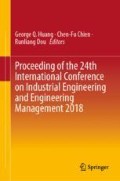Abstract
To achieve effective control of the riveting force in the electromagnetic riveting system and improve riveting efficiency, a theoretical analysis of electromagnetic riveting force is given. The Ansoft Maxwell 2D finite element software was used to establish the coil coupling model and circuit model respectively, and the numerical simulation of the influence factors of electromagnetic riveting force was studied. The results show that the electromagnetic force is perpendicular to the slave coil and is non-uniformly distributed in the radial direction, moreover, the maximum value is located at half the slave coil radius. The voltage, capacitance, inductance, and resistance in the discharge loop have a great influence on the electromagnetic force, but their effects are quite different. To verify the numerical simulation results, the electromagnetic force was actually measured and compared with the simulation results. The results show that the simulation results are credible.
Access this chapter
Tax calculation will be finalised at checkout
Purchases are for personal use only
References
H. Li, C.J. Yi, Q. Wang, Comparative analysis of compression riveting and hammer riveting of composite material. Aeronaut. Manuf. Technol. 537(18), 97–99 (2017) (In Chinese)
Z.Q. Cao, Y. Dai, Electromagnetic riveting technology for wedge-shaped composite structures. J. Aeronaut. 30(10), 1998–2002 (2009) (In Chinese)
J. Cui, L. Sun, L. Meng et al., Experimental study on electromagnetic riveting of titanium alloy rivets with carbon fiber connection structure. Forg. Stamp. Technol. 38(2), 47–52 (2013) (In Chinese)
H.P. Yu, C.F. Li, Electromagnetic riveting technology for large-diameter and high-strength rivets, in Proceedings of the 11th National Collapsing Conference on Plastic Engineering. Plastics Engineering Society of China Mechanical Engineering Society, Beijing (2009) (In Chinese)
H.P. Yu, C.F. Li, Electromagnetic riveting technology of large diameter rivet with high strength, in The 11th National Plastic Engineering Academic Annual Meeting. Chinese Institute of Mechanical Engineering Plastic Engineering Branch, Beijing (2009) (In Chinese)
Z.Q. Cao, Application of electromagnetic riveting technology in the manufacture of large aircrafts. Acta Aeronautica et Astronautica Sinica 29(3), 716–720 (2008) (In Chinese)
Z.Q. Cao, Exploration of electromagnetic riveting application in large aircraft manufacturing. Acta Aeronautica Et Astronautica Sinica 29(3), 716–720 (2008) (In Chinese)
G. Xu, M. Gao, Q. Xiao et al., Development, equipment development and application of electromagnetic riveting technology. Aeronautical Manufacturing Technology (23), 38–41 (2010) (In Chinese)
J.H. Deng, C. Tang, M.W. Fu, Y.R. Zhan, Effect of discharge voltage on the deformation of Ti Grade 1 rivet in electromagnetic riveting. Mater. Sci. Eng. A 591, 26–32 (2014)
C. Zengqiang, Coping with assembly connection technology for large aircraft development in China. Aeronaut. Manuf. Technol. 2, 88–91 (2009)
H. Jiang, G. Li, X. Zhang et al., Fatigue and failure mechanism in carbon fiber reinforced plastics/aluminum alloy single lap joint produced by electromagnetic riveting technique. Compos. Sci. Technol. 152 (2017)
X. Yang, Z.Q. Cao, Y. Zuo, et al. Experimental study on mounting process of titanium interferential bolts based on stress wave loading. J. Northwest. Polytech. Univ. 35(3), 462–468 (2017) (In Chinese)
Y. Qin, M. Gao, F. Zou, Simulation analysis of electromagnetic riveting discharge process. Aeronaut. Manuf. Technol. 474(5), 68–69 (2015) (In Chinese)
Z.Q. Cao, Electromagnetic riveting theory and application research. Northwestern Polytechnical University, Xi’an (1999) (In Chinese)
Author information
Authors and Affiliations
Corresponding author
Editor information
Editors and Affiliations
Rights and permissions
Copyright information
© 2019 Springer Nature Singapore Pte Ltd.
About this paper
Cite this paper
Chen, C., Tao, Yj., Zhu, Zk., Cao, Zq. (2019). Simulation Research on Core Control Parameters of Electromagnetic Force in Electromagnetic Riveting System. In: Huang, G., Chien, CF., Dou, R. (eds) Proceeding of the 24th International Conference on Industrial Engineering and Engineering Management 2018. Springer, Singapore. https://doi.org/10.1007/978-981-13-3402-3_39
Download citation
DOI: https://doi.org/10.1007/978-981-13-3402-3_39
Published:
Publisher Name: Springer, Singapore
Print ISBN: 978-981-13-3401-6
Online ISBN: 978-981-13-3402-3
eBook Packages: Business and ManagementBusiness and Management (R0)

